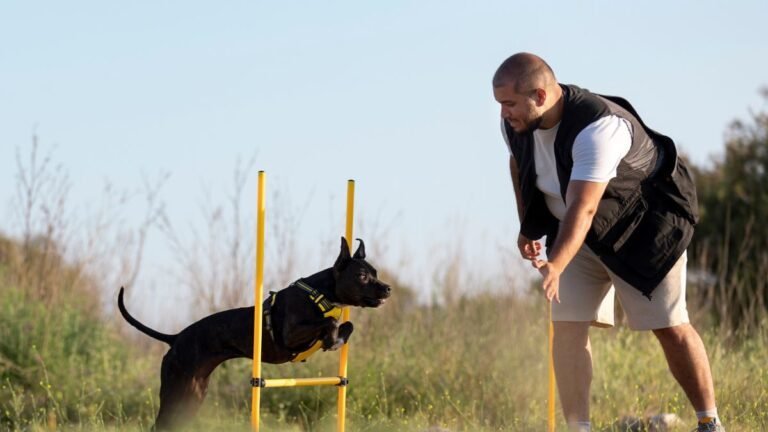Table of Contents
- Clicker Training: Precision in Action
- Luring: Guiding Your Dog
- Shaping: Building Behaviors Step by Step
- Capturing: Reinforcing Natural Behaviors
- Targeting: Teaching Focus and Control
- Consistency and Patience: Keys to Success
- Conclusion
Understanding Positive Reinforcement
Positive reinforcement is at the heart of modern dog training, utilizing rewards such as treats and praise to encourage desired behaviors. This approach not only speeds up learning but also strengthens trust and deepens the human-dog bond. At American Canine, customized training programs are designed to optimize each dog’s potential, making every session both effective and enjoyable. Unlike outdated punishment methods, positive reinforcement reduces anxiety, builds confidence, and is backed by animal learning science. Even the American Kennel Club recommends this method for improving obedience and overall canine happiness.
Clicker Training: Precision in Action
Clicker training is a simple yet highly effective method that relies on a specialized device producing a distinct “click” sound. This sound marks the exact moment your dog performs the desired behavior, making your communication crisp and clear. To start, the trainer “charges” the clicker by associating clicks with immediate treats, ensuring the dog equates the sound with positive outcomes. Once learned, the clicker can pinpoint correct responses such as “sit,” “down,” or more complex tricks. This technique is ideal for breaking down advanced behaviors into manageable steps, allowing dogs to learn more quickly and with less confusion. Its accuracy and effectiveness have been supported by scientific studies, making it a staple in modern canine education. For deeper insights on the use of clickers in behavioral science, see this resource on the importance of positivity in dog training from the American Kennel Club.

Luring: Guiding Your Dog
Luring is one of the most accessible methods for teaching basic commands. By using a treat or favorite toy held just out of reach, trainers can guide the dog’s movement into a new position, such as sitting, lying down, or spinning. As soon as the dog performs the desired behavior, they are rewarded. Over time, trainers add a verbal cue so dogs learn to respond to commands even without the lure. Luring is especially helpful for puppies or dogs new to training, as it uses their instincts to follow food or interesting objects. This clear, visual cue quickly teaches the mechanics of any new trick and builds a framework for more advanced skills.
Shaping: Building Behaviors Step by Step
Shaping is the process of rewarding progressive steps toward a final, complex behavior. For example, to teach a dog to roll over, you might first reward them for lying down; next, for turning their head; then for rolling onto their side, eventually reaching the complete roll over. This incremental approach is invaluable for advanced tricks or behaviors that aren’t easily lured or captured in one step.
Benefits of Shaping
- Encourages problem-solving in dogs
- Builds patience in both trainer and dog
- Allows teaching of sophisticated tricks and skills
Capturing: Reinforcing Natural Behaviors
Capturing relies on waiting for the dog to naturally exhibit a desired behavior—such as sitting, lying down, or stretching—then immediately marking and rewarding it. This tactic is excellent for training behaviors that can’t easily be induced by luring, such as a quiet “settle” or unique tricks like sneezing or yawning on command. It requires diligent observation and quick timing, but rewards the dog for offering behaviors voluntarily, fostering creativity and confidence.
Targeting: Teaching Focus and Control
Targeting involves training your dog to touch a specific object, such as your hand or a target stick, with their nose or paw. Begin by presenting the target; when your dog makes contact, reward instantly. This skill can then be expanded to guide your dog through advanced movements, agility courses, or daily activities, such as closing doors. Targeting is beneficial for teaching service or therapy dogs precise behaviors.
Applications of Targeting
- Teaching agility and trick routines
- Building focus during training
- Encouraging gentle, controlled movements
Consistency and Patience: Keys to Success
Achieving successful dog training requires more than just knowing the right techniques—it necessitates unwavering consistency and patient repetition. Use the same commands, hand signals, and rewards for each behavior, and maintain a regular schedule of short, focused training sessions. Remember that every dog learns at their own pace; setbacks are normal, but persistence and positivity will lead to breakthroughs. With every session you invest, you strengthen your dog’s understanding and deepen your bond. Celebrating small wins keeps motivation high for both you and your canine companion, transforming training into a rewarding experience rather than a chore.
Conclusion
Incorporating positive reinforcement techniques into your dog training routine creates an environment where your dog not only learns more quickly but also enjoys the process. Foundational methods, such as clicker training, luring, shaping, capturing, and targeting, are key to cultivating well-behaved, confident dogs. Most importantly, consistency and patience make all the difference. By prioritizing rewards and encouragement over correction, you give your dog the confidence to succeed and the willingness to learn for a lifetime.

